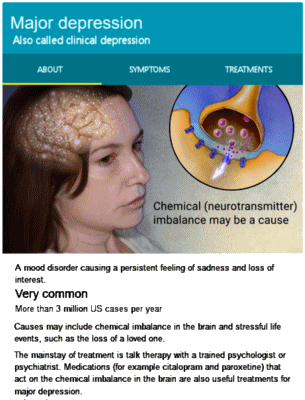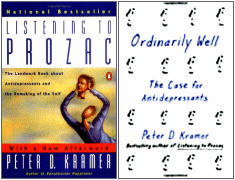A longer version of the picture below filled the right side of my screen when I inadvertently entered just the word "depression" into the Google search engine last night. At first, I thought it was an ad, but it turned out to be a help-note [?] from Google™:

 I recall a time when depression was not so clouded with guild wars or ideology, not so influenced by pharma and insurers. The past is often referred to as a simpler time, but in this case, that wasn’t true. I recall it as a better time, though anything but simpler. It was the right brand of complex in that we were clearer about what we did and didn’t know. For as much as we’ve all had to say about this topic, Ed Shorter, a primo historian of psychiatry, has condensed it down to its essence in this blog post – a response to a new book written by Peter Kramer, author of the 1993 Listening to Prozac:
I recall a time when depression was not so clouded with guild wars or ideology, not so influenced by pharma and insurers. The past is often referred to as a simpler time, but in this case, that wasn’t true. I recall it as a better time, though anything but simpler. It was the right brand of complex in that we were clearer about what we did and didn’t know. For as much as we’ve all had to say about this topic, Ed Shorter, a primo historian of psychiatry, has condensed it down to its essence in this blog post – a response to a new book written by Peter Kramer, author of the 1993 Listening to Prozac:
And like the San Andreas Fault Line, it is getting widerPsychology Today: How Everyone Became Depressedby Edward Shorter Ph.D.Jun 11, 2016…It is clear that a great fault line runs through American psychiatry on the subject of mood disorders, and that the fault line, comparable to the San Andreas Fault Line in California’s earthquake territory, is getting wider. A big quake may be coming. On one side of the fault line are those who agree with DSM that there is only one form of depressive illness, Major Depression. On the other side are people, such as myself and some other truly distinguished figures who say there are at least two depressions, as different from each other as chalk and cheese.
One is melancholic depression. The other is a mixture of anxiety, dysphoria, fatigue, insomnia and somatic symptoms– once called “nerves,” later “psychoneurosis,” “reactive depression,” and today “non-melancholic depression” or “community depression.” I don’t mean to make this second depression sound trivial. It’s certainly not for the patients who have it, who deserve relief and are legitimately ill. But it’s not melancholia. They aren’t necessarily suicidal; they are not completely lacking in any source of joy, nor are they filled with psychic and somatic pain. William Styron gave a penetrating description of melancholia in his little book Darkness Visible: A Memoir of Madness. He didn’t have psychoneurosis.
Which brings us back to Peter Kramer, who sits on the one-depression side of the fault line. The tendency in American society to dumb-down depression, by considering it all a kind of sour disaffection rather than a brush against the threshold of madness, began with a distinguished American psychiatrist named Gerald Klerman in the 1970s. There is a kind of walking track that links together Harvard, Yale, Columbia University and the National Institute for Mental Health in Bethesda, Maryland, and Klerman was a familiar figure on this track, scuttling back and forth.
Klerman’s students were highly influential, and two of them have made history. One is the late Robert Spitzer, the disease designer of DSM-3 in 1980. The other is Peter Kramer, who has a big international reputation and whose book on Prozac had a large impact on opening up the SSRI antidepressant market. This is the American psychiatric establishment. They occupy the commanding heights, and they have, more or less, imposed their views on much of the world with the ongoing success of the DSM series, which has been translated into many languages and is the world “bible” of psychiatry. The bible says one depression.
Sulking in their lonely citadels are the two-depression advocates, who rigorously distinguish between melancholia and community depression as two separate diseases, as different as mumps and tuberculosis – both infectious diseases but not the same. Nor are melancholia and non-melancholia the same. There is a biological test for many melancholic patients, the dexamethasone suppression test [DST]. Clinically, someone like William Styron is totally different from the legions of “depressed” young female undergraduates on every campus. That doesn’t mean that these young women don’t have legitimate psychological issues, but they are not Styron’s issues, who lay coiled in a fetal ball on his bed.
The difference between these two schools was brought home to me just now with an email from an internationally distinguished psychiatrist known for having helped reintroduce the idea of melancholia to medicine. He said, “I visited Gerry Klerman when he was in his last months but showed great courage about it all. He was very warm in the conversation but observed something along these lines, “[real name], I’ve never agreed with your push for melancholia.” Klerman, no longer with us, speaks for American psychiatry today. But is it the voice of science?
So many nuances here… There were endless semantic debates about the correct terms for the 2 depressions. Most of those terms carried some imputed etiological baggage, however, so the debates went nowhere until Donald Klein in 1974 cut through the Gordian knot with his very sensible new term “endogenomorphic depression.” This was a virtual synonym for melancholia, and it dispensed with the handwringing over whether a given case it was strictly autochthonous or resulted from the patient’s adverse experiences, character pathology, and developmental vulnerabilities. By this step he followed a classic tradition in psychopathology of distinguishing between the form of a disorder or a symptom and its inferred meaning.
Had the DSM-III framers understood DK’s insight, we could have avoided the introduction of Major Depressive Disorder, with all its heterogeneity. The tradeoff of throwing diagnostic validity under the bus in the name of diagnostic reliability was made for reasons that seemed specious to me. Outside the USA, melancholic depressions were generally diagnosed with good reliability. And the irony today is that reliability data for DSM-5 are pitiful – actually worse than before DSM-III.
Jeez can we just go back to DSM-II?
People don’t learn anything, except there’s no price for doubling down on failure:
http://www.clinicalpsychiatrynews.com/specialty-focus/depression/single-article-page/peter-kramer-returns-to-his-role-in-defending-antidepressants-in-ordinarily-well/56b7ba0f6147f85e350f13dc2037facf.html
This goes on for the same reason that government budgets always expand for the benefit of rent seekers…there are lobbyists for intense special interests but no incentives for anyone to lobby for the taxpayer.
Similarly there will always be KOLs for intense special interests. Scientific objectivity isn’t intense and relentless nor paying so therefore no KOLs are interested in representing it as an interest because by definition objectivity is disinterested.
Rent-seeking is the substitution of connections for productive endeavor…KOL arm-waving is a substitute for actual discovery and scientific advancement.
The only way for clinical care interventions to dramatically change for the better is to see a substantial rise in morbidity and mortality with reckless and overprescribing of psychotropics, then successful legal action against such clueless and irresponsible providers, and then those remaining in practice will see that a unidimensional approach to a multidimensional problem has serious career ending consequences for ignorant, poorly trained providers.
A run on sentence for a run on attitude that is abject failure in mental health.
Oh, and the consequences for minimizing if not denying Axis 2 factors in patient presentation, wow, where to go with that…
These patients dumped on my office door step on multiple controlled substances, these folks are the epitomy of disaster in progress…and thus lawyers needing clientele.
The irony is, I am seeing that insurance companies who contracted to MFT’s and psych assistant’s (probably) b/c psychopharm was ineffective are now requiring their contractors to make psych referrals for ‘Major Depressive Disorder.’
These are considered synonymous with “medication referrals.” So we’re coming full circle, unfortunately.
When I make these referrals, I plan to enter the room with guns blazing, raving about melancholia and big “D” depression.
If it’s a big “D” conversation, and it turns to medication, and my opinion is asked, I will inquire about judicious low-dose trials of TCAs and MAOIs.
If SSRIs are mentioned my strategy will be: Play stupid. “Really? Hmm, I didn’t know anyone was still using them.”
I’ll let you guys know how it works out. Probably about as well as hiding your weed by throwing it way up high.
As an aside: HR 2646 out of committee and potentially going to the floor of the House.
I’m a big fan of second chances but they shouldn’t be spent doubling down on failure.